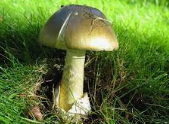Exploring the Wild: Beware of Dangerous Mushrooms in Maine
Maine’s picturesque landscapes and lush forests are a haven for outdoor enthusiasts and nature lovers alike. Among the many wonders found in these wooded realms are mushrooms, which dot the forest floor with their diverse shapes and colors. While most mushrooms in Maine are harmless and even edible, there are some species that can pose serious health risks if ingested. In this blog post, we delve into the world of dangerous mushrooms in Maine, highlighting key species to watch out for and tips on how to stay safe while mushroom hunting.
Identifying Dangerous Mushrooms
One of the most notorious and potentially deadly mushrooms found in Maine is the Amanita genus. Within this genus, the Amanita phalloides, commonly known as the Death Cap, stands out as particularly dangerous. Despite its innocuous appearance with its greenish-yellow cap and white gills, this mushroom contains toxins that can cause severe liver damage and even be fatal if consumed. It’s important to note that similar-looking mushrooms within the Amanita genus, such as the Amanita bisporigera (Destroying Angel), also pose significant health risks.
Another group to be wary of are the Galerina mushrooms, often found growing on decaying wood in Maine’s forests. These small brown mushrooms resemble certain edible varieties but contain toxins that can lead to liver failure if eaten. They are particularly dangerous because they can be mistaken for other harmless or edible mushrooms by inexperienced foragers.
Safe Mushroom Foraging Practices
Foraging for mushrooms in Maine can be a rewarding experience, but it requires caution and knowledge. Here are some essential tips to stay safe:
- Education: Familiarize yourself thoroughly with the characteristics of both edible and poisonous mushrooms. Attend workshops or classes led by experienced mycologists to learn about local species.
- Identification: Always positively identify any mushroom before consuming it. Use guidebooks, online resources, or seek guidance from experts to confirm the species.
- Avoid Risky Species: Unless you are absolutely certain of a mushroom’s identity and safety, avoid consuming it. Remember, even experienced foragers can make mistakes in identifying mushrooms.
- Never Rely Solely on Visual Cues: Visual appearance alone is not enough to identify mushrooms accurately. Pay attention to all aspects, including size, shape, color, gill structure, spore print, and habitat.
- Start Slow: If you’re new to foraging, begin with easily identifiable and commonly found edible mushrooms like chanterelles or morels. Gradually expand your knowledge as you gain experience.
- Consult Local Experts: Reach out to local mycological societies or knowledgeable foragers who can provide guidance specific to Maine’s mushroom species.
Conclusion
While Maine offers a wealth of natural beauty and resources, including a variety of mushrooms, it’s crucial to approach mushroom foraging with caution and respect. The allure of wild mushrooms can be enticing, but the consequences of misidentification can be severe. By educating yourself, exercising caution, and seeking guidance from experts, you can safely enjoy the bounty of Maine’s forests without encountering the dangers posed by poisonous mushrooms.
Remember, when in doubt, it’s always best to leave a mushroom where you found it rather than risk consuming a potentially harmful species. With responsible foraging practices and a keen awareness of the local fungi, you can enhance your outdoor adventures while staying safe and preserving the natural wonders of Maine’s forests.
